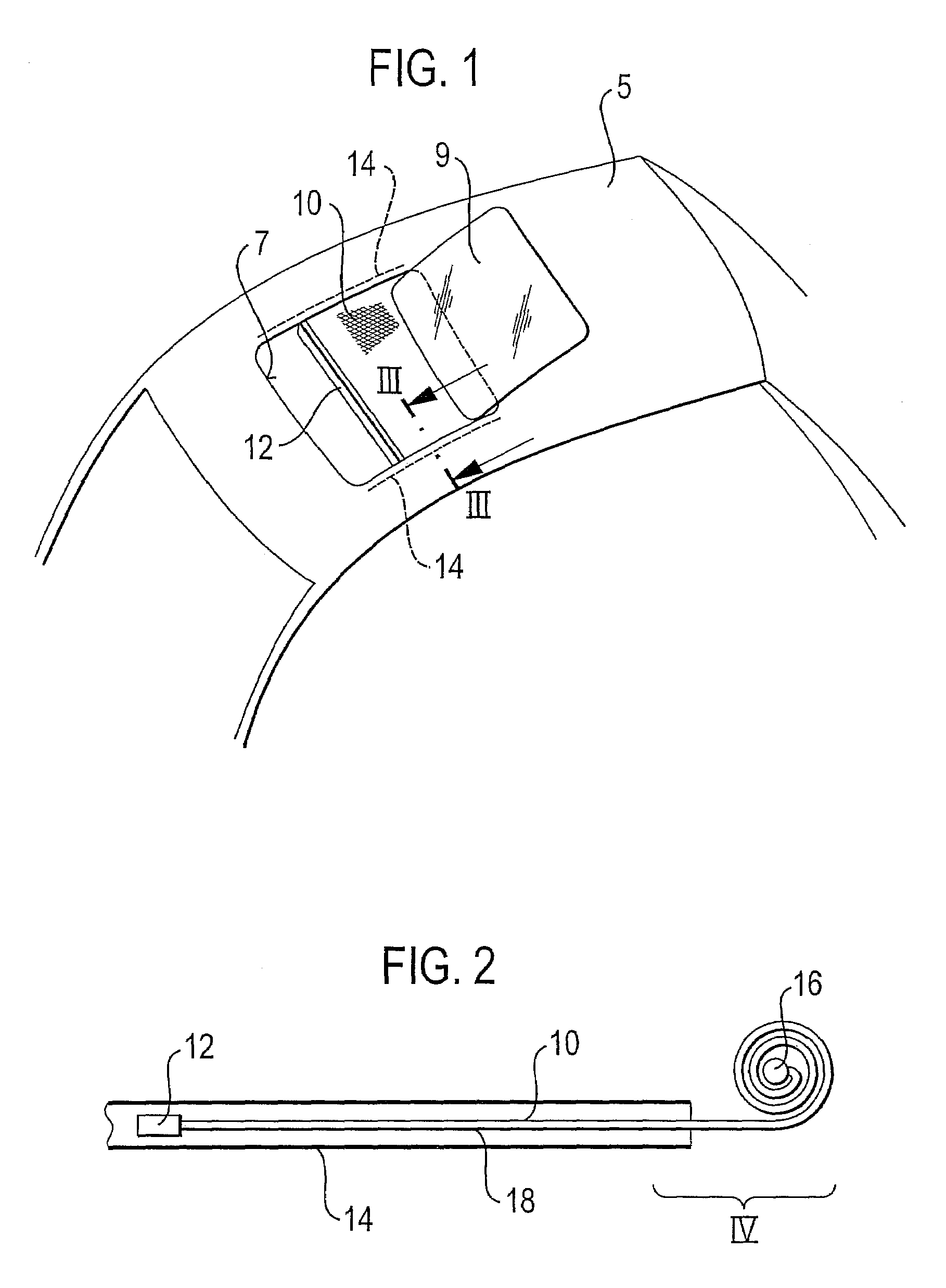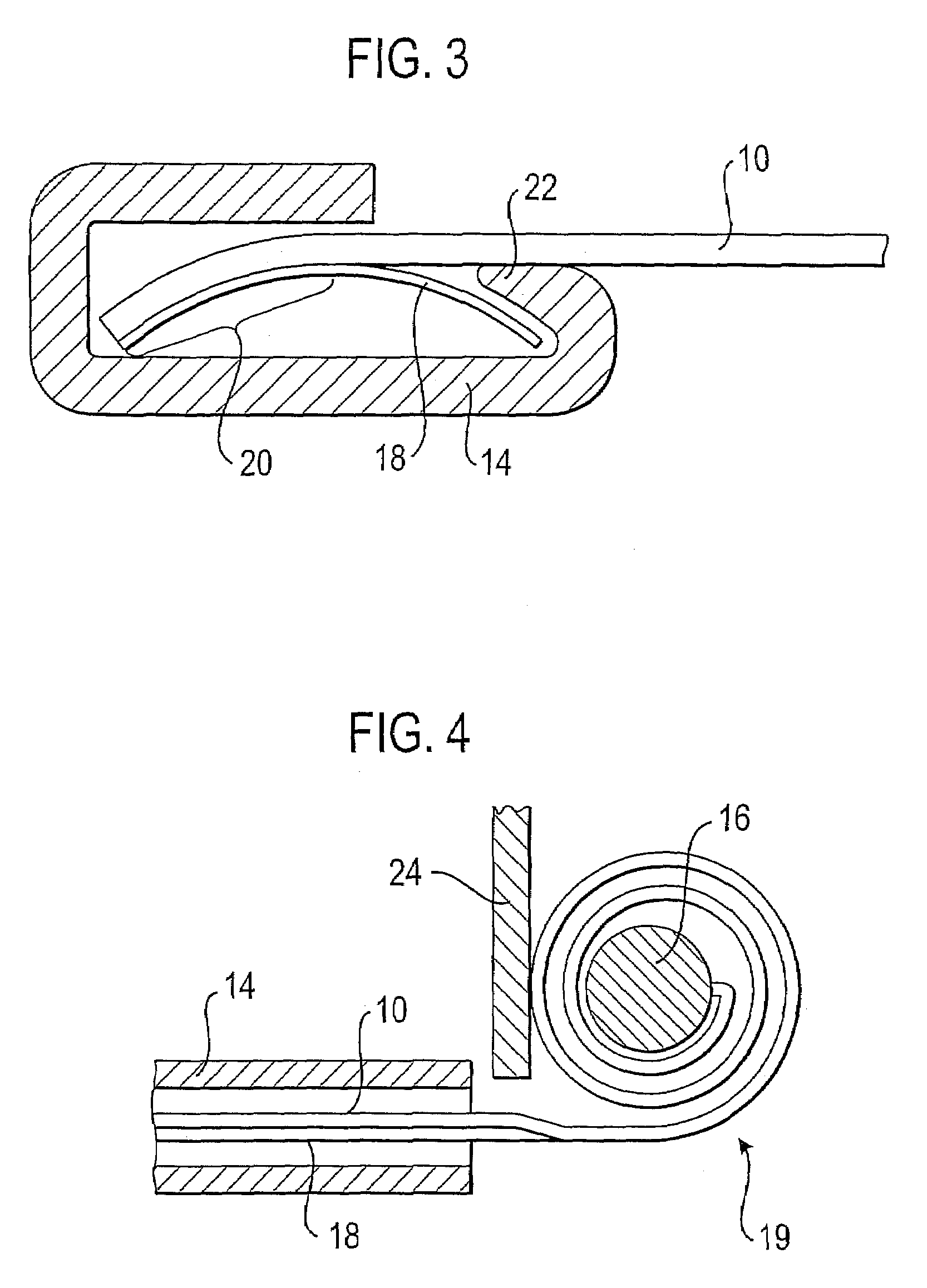Roller blind system for a sliding roof
a technology of roller blinds and sliding roofs, which is applied in the direction of doors/windows, roofs, and movable grilles, etc., can solve the problems of changing the operating force of the guide rail, the deviation of the operating force of the roller blind in the guide rail, so as to minimize the variance of the roller blind during the shifting
- Summary
- Abstract
- Description
- Claims
- Application Information
AI Technical Summary
Benefits of technology
Problems solved by technology
Method used
Image
Examples
first embodiment
[0025]the roller blind system according to the invention will now be described on the basis of FIGS. 5 and 6. The same reference numerals will be used for the components which are known from FIGS. 1 to 4, and reference is made to the above explanations.
[0026]The embodiment according to FIGS. 5 and 6 is distinguished in that the spring steel bands 18 are extended beyond a front end of the roller blind 10 and a front end of the guide rails 14, so that an auxiliary coil 50 forms on that side of each guide rail 14 which is opposite the roller blind coil 19. Generally spoken, this auxiliary coil 50 is a mirror image of the roller blind coil 19 (see also auxiliary wall 52), with the difference that the roller blind 10 never can be in a region of the auxiliary coil 50; even if the roller blind 10 is completely closed, a front edge of the roller blind 10 lies between the guide rails 14 and, hence, is not in the region of the auxiliary coil 50. The two spring steel bands 18 are realized with...
second embodiment
[0030]the roller blind system according to the invention will now be explained on the basis of FIG. 7. The same reference numerals will be used for the components which are known from the preceding figures, and reference is made to the above explanations.
[0031]In place of the auxiliary coil 50, a compensation spring 60 is used in the second embodiment, which is configured as a tension spring. One end of the compensation spring 60 is immovably attached, and another end of the compensation spring 60 is attached to a front end of the spring steel band 18, for instance in the region of the roof stick 12.
[0032]The compensation spring 60 generates a force that opposes the return force of the roller blind coil 19, so that the roller blind 10 can be moved in both shifting directions with approximately the same operating force.
third embodiment
[0033]the roller blind system according to the invention will now be explained on the basis of FIGS. 8 and 9. The same reference numerals will be used for the components which are known from the preceding figures, and reference is made to the above explanations.
[0034]Like in the roller blind system illustrated in FIGS. 1 to 4, only one roller blind coil 19 is used in the third embodiment; the front end (for instance on the roof stick 12) of the spring steel band 18 is not engaged by a spring. A compensation spring 70 is provided instead, which is configured as a compression spring. This compression spring acts on a friction element 72 which presses the roller blind coil 19 in the nature of a brake. An end of the compensation spring 70 facing away from the friction element 72 is statically supported.
[0035]The compensation spring 70 is dimensioned such that the braking force, exerted by the compensation spring 70 in conjunction with the friction element 72, reduces (owing to a reducti...
PUM
 Login to View More
Login to View More Abstract
Description
Claims
Application Information
 Login to View More
Login to View More - R&D
- Intellectual Property
- Life Sciences
- Materials
- Tech Scout
- Unparalleled Data Quality
- Higher Quality Content
- 60% Fewer Hallucinations
Browse by: Latest US Patents, China's latest patents, Technical Efficacy Thesaurus, Application Domain, Technology Topic, Popular Technical Reports.
© 2025 PatSnap. All rights reserved.Legal|Privacy policy|Modern Slavery Act Transparency Statement|Sitemap|About US| Contact US: help@patsnap.com



